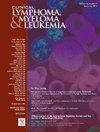他克莫司与现实世界中医生选择的治疗方法:三类药物暴露的复发性/难治性多发性骨髓瘤患者的疗效比较。
IF 2.7
4区 医学
Q2 HEMATOLOGY
引用次数: 0
摘要
背景:他克单抗被批准用于治疗复发/难治性多发性骨髓瘤(RRMM)的三类暴露(TCE)患者。我们评估了MonumenTAL-1研究中的他昔单抗与现实世界中医生选择(RW)治疗的疗效比较:MonumenTAL-1 的外部对照组由 Flatiron Health 数据库中符合 MonumenTAL-1 资格标准的患者组成(n = 629,1169 个符合条件的治疗方案)。MonumenTAL-1的患者水平数据包括接受皮下注射talquetamab 0.4 mg/kg QW(n = 143)和0.8 mg/kg Q2W(n = 145)的患者。调整基线协变量不平衡后,评估了无进展生存期(PFS)、下次治疗时间(TTNT)和总生存期(OS)的比较效果:结果:经调整后,各组群的基线协变量具有可比性。Talquetamab 0.4 mg/kg QW队列和0.8 mg/kg Q2W队列的PFS(HR,0.55 [95% CI,0.44-0.69;P < .0001;中位数,7.5个月对4.0个月]和0.40 [95% CI,0.31-0.53;P < .0001;中位数,14.2个月对4.0个月])、TTNT(HR,0.59 [95% CI,0.47-0.74;P < .0001;中位数,9.2个月对4.0个月])和OS均有显著改善。0001; 中位数,9.1 个月 vs. 5.1 个月] 和 0.45 [95% CI, 0.35-0.59; P < .0001; 中位数,13.3 个月 vs. 5.1 个月]),以及 OS(与 RW 治疗相比,HR,0.56 [95% CI, 0.40-0.78; P = .0007; 中位数,NR vs. 16.5 个月] 和 0.48 [95% CI, 0.33-0.70; P = 0.0002; 中位数,NR vs. 15.9 个月]):结论:在所有评估结果中,两种talquetamab治疗方案的疗效均优于RW治疗方案。这些数据表明,在TCE RRMM患者中,talquetamab是一种有效的免疫疗法。本文章由计算机程序翻译,如有差异,请以英文原文为准。
Talquetamab Versus Real-World Physician's Choice Treatment: Comparative Effectiveness in Patients With Triple-Class Exposed Relapsed/Refractory Multiple Myeloma
Background
Talquetamab is approved for treatment of triple-class exposed (TCE) patients with relapsed/refractory multiple myeloma (RRMM). We evaluated the comparative effectiveness of talquetamab in the MonumenTAL-1 study versus real-world physician's choice (RW) treatment.
Materials and Methods
An external control arm for MonumenTAL-1 was created from patients in the Flatiron Health database who satisfied MonumenTAL-1 eligibility criteria (n = 629 with 1169 eligible lines of therapy). Patient-level data from MonumenTAL-1 were included for patients who received subcutaneous talquetamab 0.4 mg/kg QW (n = 143) and 0.8 mg/kg Q2W (n = 145). After adjusting for baseline covariate imbalances, comparative effectiveness was assessed for progression-free survival (PFS), time to next treatment (TTNT), and overall survival (OS).
Results
Baseline covariates were comparable across cohorts after adjustment. Talquetamab 0.4 mg/kg QW and 0.8 mg/kg Q2W cohorts, respectively, showed significant improvement in PFS (HR, 0.55 [95% CI, 0.44-0.69; P < .0001; median, 7.5 vs. 4.0 months] and 0.40 [95% CI, 0.31-0.53; P < .0001; median, 14.2 vs. 4.0 months]), TTNT (HR, 0.59 [95% CI, 0.47-0.74; P < .0001; median, 9.1 vs. 5.1 months] and 0.45 [95% CI, 0.35-0.59; P < .0001; median, 13.3 vs. 5.1 months]), and OS (HR, 0.56 [95% CI, 0.40-0.78; P = .0007; median, NR vs. 16.5 months] and 0.48 [95% CI, 0.33-0.70; P = 0.0002; median NR vs. 15.9 months]) versus RW treatment.
Conclusion
Both talquetamab schedules demonstrated superior effectiveness over RW treatment for all outcomes assessed. These data suggest talquetamab as an effective immunotherapy option in patients with TCE RRMM.
求助全文
通过发布文献求助,成功后即可免费获取论文全文。
去求助
来源期刊

Clinical Lymphoma, Myeloma & Leukemia
ONCOLOGY-HEMATOLOGY
CiteScore
2.70
自引率
3.70%
发文量
1606
审稿时长
26 days
期刊介绍:
Clinical Lymphoma, Myeloma & Leukemia is a peer-reviewed monthly journal that publishes original articles describing various aspects of clinical and translational research of lymphoma, myeloma and leukemia. Clinical Lymphoma, Myeloma & Leukemia is devoted to articles on detection, diagnosis, prevention, and treatment of lymphoma, myeloma, leukemia and related disorders including macroglobulinemia, amyloidosis, and plasma-cell dyscrasias. The main emphasis is on recent scientific developments in all areas related to lymphoma, myeloma and leukemia. Specific areas of interest include clinical research and mechanistic approaches; drug sensitivity and resistance; gene and antisense therapy; pathology, markers, and prognostic indicators; chemoprevention strategies; multimodality therapy; and integration of various approaches.
 求助内容:
求助内容: 应助结果提醒方式:
应助结果提醒方式:


